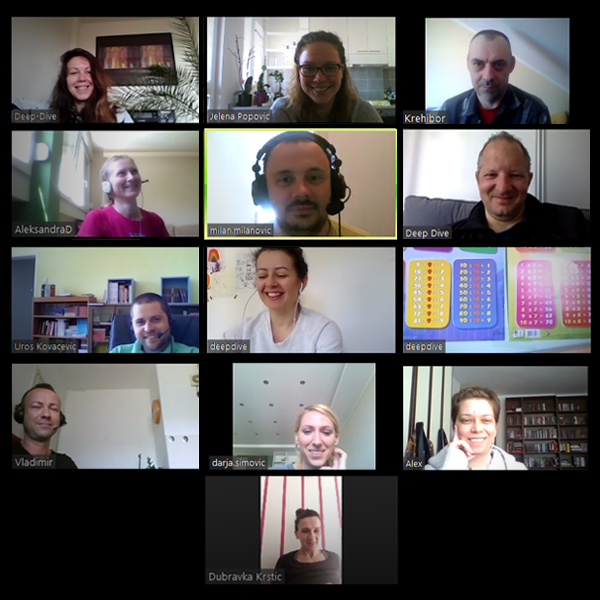Our belief is that there are no good-for-all solutions. Tools and methodologies should meet clients’ needs, not vice versa. Each business problem is different and unique.

WHO WE ARE
Deep Dive is a full-service market research agency established in 2013.
Our belief is that there are no good-for-all solutions. Tools and methodologies should meet clients’ needs, not vice versa. Each business problem is different and unique.
WHAT WE DO
Qualitative Solutions
We discuss in following situations:
– When we want TO HEAR TARGET’s opinion
– PROVOKE DISCUSSION AND CONFLICT of opinions
– Tap on NEW INSPIRATIONS
– EVALUATE MATERIALS: ads, storyboards, web-sites
– Listen to the VERBAL MANNER of the target groups
In order to gain:
– Category and brand understanding
– Image and meaning of brands
– Brand key / essence
– Introduce and evaluate new communications
– Confront attitudes in order to understand them better
How we apply?
– Classical / regular focus groups
– Prolonged / shortened focus groups
– Individual interviews
– B2B interviews
– Conflict dive
– Role play
When we apply?
– When the answers of WHAT PEOPLE TELL US IS NOT ENOUGH
– We want to CROSS THE GAP BETWEEN ATTITUDES AND BEHAVIOURS
– Explore and observe in a more NATURAL CONTEXT – pub, home, shop
In order to:
– Reveal unsatisfied territories
– Inspire new solutions
– Enable real contact between products/ producers and consumers
How do we apply?
– Observation in situations
– Video/ audio diaries, photography
– Shopping
– Collages, artefacts, mementos,
– Guerrilla interviews
– Shop along
– Process participation / observation (cooking, big night out, cleaning…)
– And tailor made sessions
When do we apply?
– When there is a NEED FOR INNOVATION/ REPOSITION on the market
– REINVENTION of the brand
– CONCEPT DEVELOPMENT and evaluation
– COMMUNICATION development
In order to:
– Make existential progress on the market and differentiate
– Answer the unanswered and new needs of the targets
– Challenge current needs
– Expand target
How do we apply?
– Inspiration collection – ethnographies, historical data, focus groups
– Trending
– Inspiration turning into the concepts / ideas
– Workshops modelling
Concept evaluation
When do we apply?
– Problem definition
– Definition of the objectives for the future research
– Ideation process
– Research results interpretation and implementation
In order to:
– Better define problem
– Reveal ways for potential approach to the problem
– Understand and bring to reality results of the research
– Build team
When do we apply?
– When we need to approach to specific target groups
– With specific, internet related topics
– New media / trends / life style immersion into the target groups
– When lacking time
In order to:
– Gain fast results
– Provoke discussion in the natural context for specific target groups
– Be in line with the modern and fast pace of life
How do we apply?
– Via our own online community platform
– Newsgroups
– Social listening
– Social networking
– Semantic online content interpretation
When do we apply?
– In need for better context understanding – insights on cultural background, values and history
– Qualitative segmentation – position elements of market reality according to the perceptive criteria
In order to:
– Make a motivational base for the quantitative segmentation
– Need to understand the wider cultural background for category/ brand positioning
– Gaining insights through groups, interviews, experts’ interviews, diaries… And putting them in the motivational segmentation frame based on psychological models
– Putting the insights in the map
– Explain market behaviour through needs, motivations
– Position in accordance to those needs
Quantitative Solutions
Knowing how people perceive your brand is fundamental for understanding the market.
Our tools allow us to sum up differences and similarities among brands to only one comprehensive map showing current position of each brand in the market.
Moreover, taking into account both relative importance of each image attribute and performance of your brand for that attribute, we can identify areas of improvement, characteristics for whom performance has to be improved (brand weaknesses) and key strengths of your brand image.
Are you screening several concepts and need to choose one? Are you wondering whether your concept is appealing, innovative, different and at the end feasible enough to be launched? If you launch it, is it going to result in “cannibalism” with brands from your own portfolio? Or, you just want to reformulate and optimize an existing product to increase/sustain profitability?
We have solutions applicable in all stages of product life cycle.
Our sensory testing methodology enables us to analyze product features in detail and provide you with full organoleptic profile, identifying characteristics that should be changed to increase overall appeal and give you clear directions for product modification.
In addition to pricing techniques that have been around for long and became an industry standard (such as Van Westendorp or Gabor- Granger), we also offer Conjoint Analysis which is much more than a pricing technique.
It is based on tradeoffs that provide a more realistic context, thus a powerful way of capturing what really drives customers to buy one product over another and what customers really value.
Key benefit of conjoint analysis is the ability to produce dynamic market models – simulators that enable you to try out different scenarios.
Market segmentation is necessary for understanding consumers and the category as a whole.
In consumer based segmentation, the goal is to gain insight into needs and values of users. On the other hand, occasion based segmentation reveals situations that are potential for growth and usage occasions that bring higher volume than others.
Our model takes into consideration usage motivation, what users believe a perfect brand should be like, the way consumers perceive themselves and what they think an ideal product should be like in terms of functionality.
Ads may and should be (re)tested in different stages of development – from storyboard to fully finalized commercial. Our methodology provides a measure of whether an execution is or will be effective. It also identifies elements that must be changed to maximize performance.
Consumers have needs and the brands that best satisfy them will be most successful. We take these psychological needs into consideration as well. This allows us to tell you whether you should adjust your execution or revise your communication strategy in order to align it with what people actually want to see.
There are many points of interaction between customers and companies as well as between employees and employers. All of them have to be taken into account if we want to figure out what really makes people satisfied or dissatisfied.
That is why we use scales that capture ratings relative to competition across different points of interaction.
We are also capable of conducting Mystery Shopper studies.
GET IN TOUCH
We are always open for new collaboration opportunities. If you have an idea which you would like to explore with us, please get in touch.
Come And Meet Us
11000 Belgrade, Serbia






